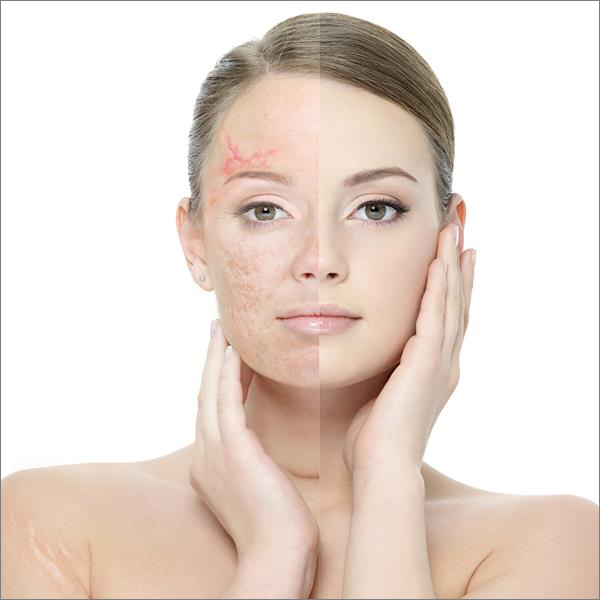Posted July 15, 2024 in Keloid Scar Removal

Understanding Scars: What They Are and How to Treat
Scars are an inevitable part of the body’s healing process after a skin injury or surgery. When the skin sustains damage, the body repairs itself by forming new tissue primarily composed of collagen. This natural response can lead to the development of scars, which vary significantly in size, shape, and appearance. Some scars may be prominent and painful, while others can be subtle and barely noticeable.
Why Do Scars Form?
Scarring occurs as a result of the body’s complex healing mechanism. When skin is injured, the body activates a cascade of biological processes to repair the wound. During this process, fibroblasts produce collagen, a vital protein that helps form new tissue. Unfortunately, this healing can result in varying scar types depending on factors such as the depth of the injury, individual skin type, and genetic predisposition.
Who is Prone to Scarring?
Certain individuals may be more susceptible to developing specific types of scars. For instance, people with darker skin tones—such as those of African, Asian, or Hispanic descent—are at an increased risk for keloid scars. These scars extend beyond the original injury site and can be larger and raised, potentially impacting both aesthetics and mobility. Additionally, individuals with red hair are also more prone to developing abnormal scar tissue.
Types of Scars
Understanding the different types of scars can help in choosing the right treatment. Here are some common types:
1. Contracture Scars
Often resulting from burns, contracture scars tighten the skin and can affect movement, particularly around joints. They may lead to limitations in mobility and function.
2. Depressed (Atrophic) Scars
These sunken scars resemble ice picks and often occur from acne or chickenpox. They are most commonly found on the face and can be more challenging to treat.
3. Flat Scars
Initially raised, flat scars tend to flatten as they heal. They often start as pink or red and may change color over time, becoming less noticeable.
4. Keloid Scars
Keloids are raised scars that extend beyond the original injury site. They can be large, raised, and sometimes painful, significantly affecting the aesthetic of the skin and potentially restricting movement.
5. Raised (Hypertrophic) Scars
These scars are raised and palpable but remain confined to the injury site, unlike keloids. They often become less prominent over time.
6. Stretch Marks
Stretch marks occur from rapid skin stretching or shrinking, commonly seen during pregnancy, puberty, or weight changes. They often appear on the breasts, stomach, thighs, and upper arms.
Why Scars Matter
While many scars fade and become less noticeable over time, some can cause discomfort or impact an individual’s appearance and self-esteem. At Mountcastle Plastic Surgery & Vein Institute and Mountcastle Medical Spa and Laser Center, we provide a range of treatments tailored to your specific needs to help improve the appearance and symptoms of scars.
Personalized Treatment Plans
Your treatment plan will be customized based on several factors:
- Type, size, and location of the scar
- Whether the scar causes discomfort or affects mobility
- Your age and the scar’s maturity
Treatment Options at Mountcastle Plastic Surgery & Vein Institute
1. Injectables: Dr. Mountcastle administers corticosteroid injections directly into keloid scars to flatten their appearance and reduce size. This targeted approach is effective for managing raised scars.
2. Topical Creams and Ointments: Silicone ointments are recommended to minimize scar size and prevent excessive formation. Additionally, corticosteroid creams and silicone gel sheets can promote scar improvement.
3. Scar Revision Surgery: For more severe scarring, various surgical procedures can remove or improve the appearance of scars. This can include skin grafts from other areas, effectively replacing one type of scar with a more favorable outcome.
4. Z-Plasty: Dr. Mountcastle employs the Z-plasty technique, which is highly effective in scar revision. This method can lengthen contracted scars and realign scars with natural skin tension lines, enhancing aesthetics and camouflage.
Treatment Options at Mountcastle Medical Spa and Laser Center
1. Topical Creams and Ointments: As with the surgical center, applying silicone ointment is crucial for scar management. Corticosteroid creams or silicone gel sheets may also be recommended for optimal results. For individuals with darker skin tones, skin-lightening creams containing hydroquinone can help lighten scars.
2. Laser Treatments: Our center offers advanced laser therapies to diminish scars, including acne scars. Different laser and light treatments utilize specific wavelengths to target and improve skin conditions. Available options include:
- Fraxel Laser: Known for its ability to treat a variety of skin issues, including scars.
- Intense Pulsed Light (IPL): Effective in reducing redness and improving skin tone.
- SkinPen Microneedling: Promotes collagen production and enhances skin texture.
- SkinPen Microneedling with PRF (Platelet Rich Fibrin): Combines microneedling with growth factors for enhanced healing.
- RF Microneedling with Morpheus8: Targets deeper layers of the skin for more significant improvements.
- CO2 Laser: Ideal for severe scars and skin resurfacing.
Achieve Smoother, Radiant Skin
At Mountcastle Plastic Surgery & Vein Institute and Mountcastle Medical Spa and Laser Center, our comprehensive treatments are designed to enhance the appearance of scars, tailored to meet your specific needs and skin type. Our goal is to provide effective solutions and personalized care, helping you achieve smoother, more radiant skin.
Contact Us Today
If you’re looking to improve the appearance of your scars or alleviate discomfort, contact us today to schedule a consultation. Discover how our expert team can help you feel more confident in your skin and enhance your overall well-being through personalized scar treatment options. For more information about our services, visit our website.